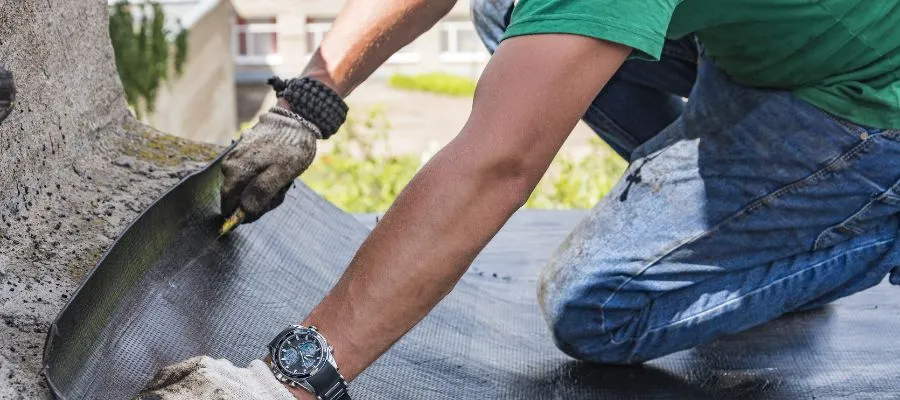Waterproofing is one of the most important things to consider when building a new house. It is an important part of keeping your home safe from water damage, which can cause expensive repairs and structural problems if you don’t fix it. Because there are so many waterproofing products on the market, it can be hard to pick the right ones. In this blog, Brick & Bolt will discuss about waterproofing.
What is Waterproofing?

Waterproofing is the process of keeping water from getting into a surface or building. It means using special tools and materials to prevent water from getting through a building’s floors, walls, roofs, and other parts. If you do not properly waterproof your house, it could lead to expensive repairs, mold growth, and even damage to the structure over time.
Why should I Waterproof my Building?
Here are a few reasons:
1. Avoid Water Damage:
Water can damage building materials, causing them to rot, grow mold, and fall apart. The right waterproofing will protect your home from these problems.
2. Increase Lifespan:
By stopping water from getting in, waterproofing helps your home’s structure last longer, saving you money in the long run.
3. Maintain Indoor Air Quality:
Mold and mildew can grow in damp places, lowering the air quality inside your home and being dangerous for people with asthma or allergies.
4. Protect Valuables:
Water damage can destroy personal items, furniture, and other valuables stored in your home. Waterproofing protects these things from damage.
When should I Waterproof my Building?
But if water damage or leaks are found in an old home, waterproofing solutions may also be needed. Here are some common situations where you might want to think about waterproofing:
1. New Construction:
Proper waterproofing should be done during the first stages of building your home to ensure its long-term safety.
2. Basements or Crawl Spaces:
These are places where water and wetness can easily get in, so they need to be waterproofed.
3. Bathroom and Kitchen Renovations:
Waterproofing should be the first step when remodelling places with high moisture, such as baths and kitchens.
4. Roof Replacement or Repair:
Roofs are common places where water can get in, so roof waterproofing should be done when it is replaced or fixed.
Types of Waterproofing:
Waterproofing in building construction includes many methods, each with its own advantages and applications.
1. Bituminous Coating Waterproofing:
A bituminous coating is sprayed with a liquid that hardens to make a waterproof barrier that doesn’t gape. Bituminous paints are flexible and can be used on many surfaces, such as concrete, brickwork, and even membranes that are already in place.
2. Polyurethane Liquid Membrane Waterproofing:
These coats are applied with a liquid and hardened to make a seamless, stretchy, and long-lasting waterproof membrane. Polyurethane liquid membranes can be used to cover many different things, such as roofs, decks, and buildings below ground.
3. Liquid Waterproofing:
These are coatings applied with a liquid and hardened to make a waterproof shield that doesn’t show seams. Liquid waterproofing is flexible and can be used on many surfaces, such as concrete, brick, and even barriers that are already in place.
4. Cementitious Waterproofing:
This type of waterproofing uses a cementitious slurry or coating. When it dries, it forms a barrier that keeps water out. Many use it to build basement walls, supports, and other things out of concrete.
Types of Waterproofing Materials:
There are a few things you can think about when choosing the best waterproofing products for your new home:
1. Bituminous Membranes:
These thin, stretchy membranes stick to themselves. They are made of modified bitumen and are often strengthened with polyester or fiberglass. They are widely used for foundations, below-grade work, and waterproofing roofs.
2. PVC and TPO Membrane:
These are made of thermoplastic materials and are very long-lasting. They are also resistant to UV light and can waterproof the roof and below-grade applications.
3. Liquid Rubber Coatings:
These elastomeric coatings are seamless and can be put on many surfaces, such as concrete, brickwork, and membranes that are already in place. They are good at keeping water out and won’t crack or peel.
4. Crystalline Waterproofing Admixtures:
These are added to concrete while it is being mixed. When they combine with water, they make crystals that can’t be broken down. These crystals then seal the pores in the concrete and make it waterproof.
5. Drainage Boards and Dimple Membranes:
These are used with other waterproofing materials to make a drainage plane and keep the waterproof cover from getting damaged.
6. China Mosaic Waterproofing:
This old technique involves putting down a layer of China mosaic tiles mixed with a waterproof mortar. This makes a waterproof barrier that doesn’t show and lasts long on patios, balconies, and other open areas.
7. Brick Bat Coba Waterproofing:
First, a layer of waterproof mortar is put down. Then, a layer of broken bricks set in cement mortar is added. Finally, a protected screed layer is added. Many people use this method to waterproof terraces and other flat areas.
8. Waterproofing Chemicals and Sealants:
To waterproof joints, cracks, and other areas, you can use silicone-based sealants, epoxy coats, and polyurethane sealants, among other chemicals.
In conclusion, getting the right waterproofing materials is important to prevent water damage to your new home and ensure its long-term durability. By learning about the different waterproofing methods and materials available, you can make a choice that fits your needs and budget. Remember that good waterproofing keeps your home safe and gives you peace of mind, knowing that your investment is well protected from the weather.

